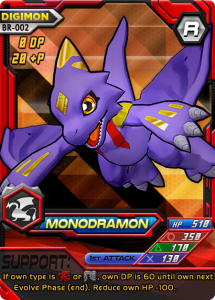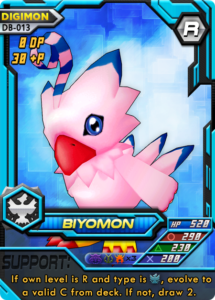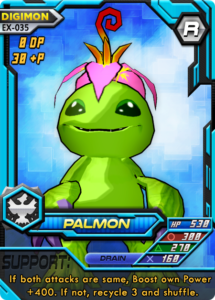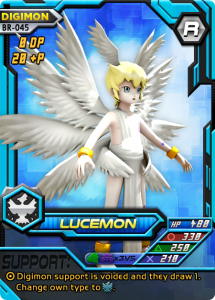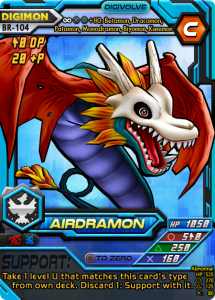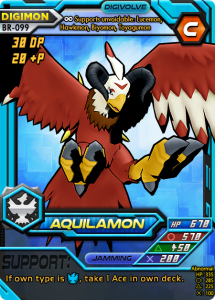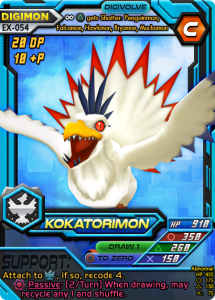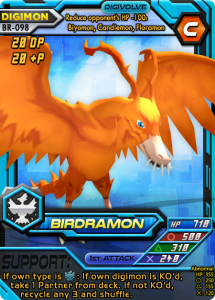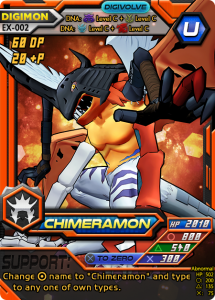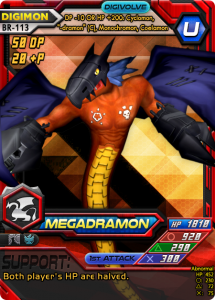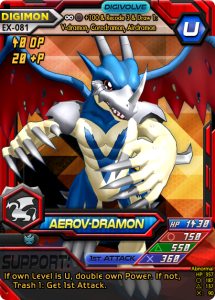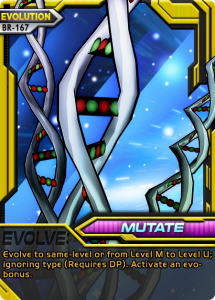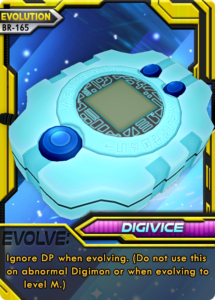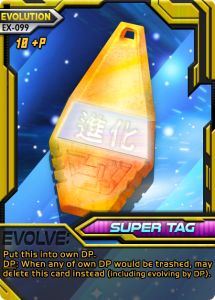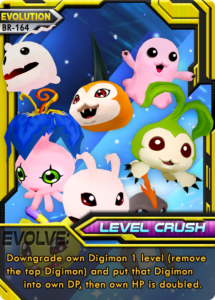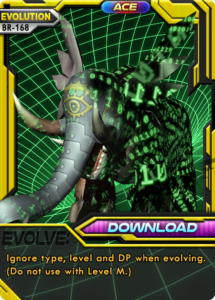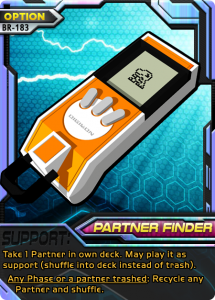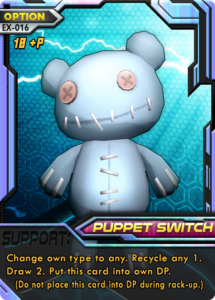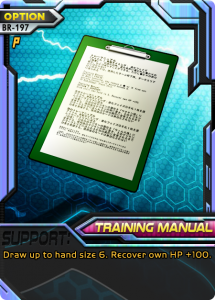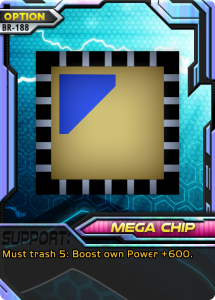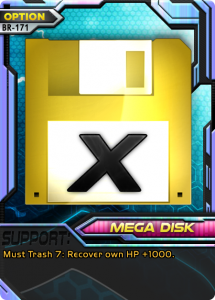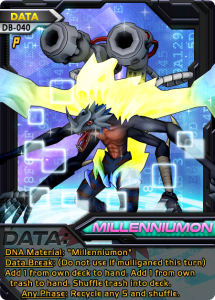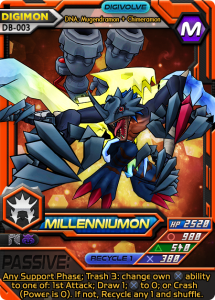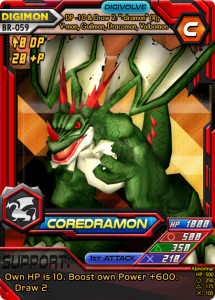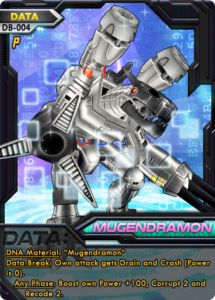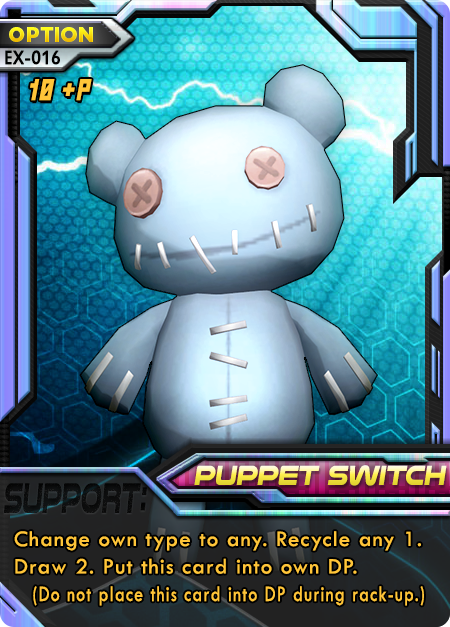Digi-Deck: Time Stop

For high skill players, the deck also tends to have a lack of good prediction effects. Only Millenniumon and Airdramon have good To-Zero specials, with the former’s requiring a turn to set it up. Airdramon won’t be a body on the field for long, but that can hypothetically increase the usability of its To-Zero. Kimeramon has a Cross To-Zero but would rarely use it unless it’s time to evolve or the opponent can gain way too much advantage from a 1st Attack, x3 VS, or Drain ability. Outside of these mundane cases, Set EX Palmon exists in the deck which can give an attack-prediction for +400 Power. This can be absolutely crucial, but if not recycled, is highly limited. Due to the limited predictive power, it is an easier deck to play but also one with less maximum potential.
Types
Primary type: (22)
Lesser types: (8) | (5)
Rare types: (4) | (2)
Mostly weak to Wind x3 VS, but several additional weaknesses occasionally.
Suggested pre-setup side choices:
Prioritize removing these particular cards in the pre-setup. Adjust to your matchup.
- Millenniumon DATA
- 2 Mutates + 1 Silver ball
- Level Crush
- Vending Machine
This pre-setup removal will prioritize getting as much early-game as possible and minimizing late game. Most games, I will remove the Mutates and Silver Ball over the 3 Firewalls in the deck, just because Firewalls are technically more viable early game most of the time. Level crush is absolutely dead. Millenniumon DATA could be good but only if you lead with an early lot of trashing, which is rare. Vending Machine is even worse because it’s also slow.
Credit for the original list goes to member SubZero.
See visual list for specific card versions whenever ambiguous.
Key Points
In the briefest of terms, this is a juggernaut of a deck. It’s incredibly fast and incredibly tooled. Let’s take a look at some of its strengths and weaknesses, and keep these in mind while playing:
- Incredibly fast. Download, Digivice, Super Tag, and several +30P Digimon make this deck a monster of speed. Skips levels regularly.
- High endurance. Usually, speed decks lack endurance because they skip crucial stepping stones like Champion Digimon, removing hit-absorption before healing through evolution. This deck uses Download and Mutate to repeatedly skip around level Ultimate, healing constantly. In addition, it Level Crushes from Mega to Ultimate for the same effect. Immense endurance.
- High Power. Speed decks tend to lack consistent matchup power as opponent catch up to their level. However, this deck abuses high-body Digimon and doesn’t suffer low power here.
- Inevitability engine. Millenniumon plus his DATA and other picky recycles (Birdramon) allow this deck to continuously weed out the unnecessary cards through the course of the game. Bricking becomes non-existent by late game.
- Early game can brick. Due to high reliance on Evolution cards to set up, your early game is incredibly vulnerable to well-placed Death Evolutions and simple miss-hands. Mitigate with a liberal opening game mulligan and have a backup plan to evolve orthodox.
- Vulnerable if it has to mulligan too much. Some decks can bounce back and typically one with this much recycle can, but it tends not to be enough. In fact, the deck tries to actively put bulk in the trash. Surprisingly vulnerable to a trash-oriented deck.
- Control decks make this a tough matchup. You don’t have much to recover hand size other than set DB Biyomons and single cards. If someone can effectively keep your hand low and fog the game long enough, there’s not many tricks in this deck to overcome that.
- Circle punishment is devastating. This is a deck that is overly-reliant on Circle until it gets Millenniumon, where it can ride Cross to victory.
- Lower-level cards are devastating. Data Hijack, Black Gear, Whistle, and the list goes on… low-level cards can grind this deck to a screeching halt, allowing the opponent ample time to catch up. This effectively nullifies all of the speed the deck has built to that point. It would then need to solely rely upon endurance and its inevitability engine.
If Digimon Battle Evolution had tournaments, this is the style of deck I would expect to see at top levels of play. It gets checked hard against Rookie-counter, low-level Crash, and rush decks that pack Circle-hate, but it plays the long game while also setting up totally insurmountable Digimon early. In this respect, it might be comparable to Magic‘s “Tron” deck type in modern. If you’re the type of player that likes to get in early, have a ton of contingency plans, and set up for the long winter, give Time Stop a go!
Credit again, for the original deck list should go to member SubZero. Mostly with respect to the bold idea to have the DATA as the proxy, repeatedly abuse Download, and use a Wind core for consistency. This version of the deck has been adapted to the deck list legality changes that allow more cards (50 shared between the DZ and main deck, adding +6 cards to the deck) and to further refine its main strategy.
